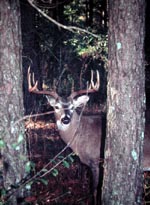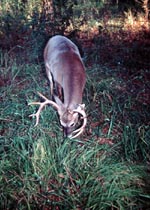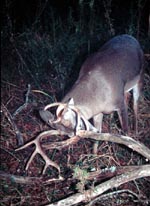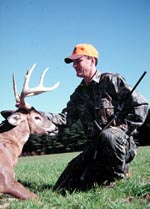
|
Features
|
|
|
|
Books
|
|
|
|
Fun & Games
|
|
|
|
Contact Us
|
|
|
John's Journal... Entry 130, Day 5
THE SUPER GENE
Managing A Deer Herd For Big Bucks
 EDITOR'S
NOTE: What role does genes play in your local deer herd? Can the introduction
of a monster buck into a herd assure quality deer for years to come? The
answer to these and other questions will definitely surprise you. I talked
with Dr. Harry Jacobson, one of the nation's leading deer researchers
from Mississippi State University in Starkville, Mississippi, who currently
studies genetic effects on deer populations.
EDITOR'S
NOTE: What role does genes play in your local deer herd? Can the introduction
of a monster buck into a herd assure quality deer for years to come? The
answer to these and other questions will definitely surprise you. I talked
with Dr. Harry Jacobson, one of the nation's leading deer researchers
from Mississippi State University in Starkville, Mississippi, who currently
studies genetic effects on deer populations.
QUESTION: At what age does the white-tailed buck reach
maturity?
ANSWER: We consider 5- or 6-year-old bucks as mature. In most sections
of the country, outdoorsmen primarily take bucks 1- to 3-years old. But
hunters will have bigger bucks to harvest if they permit the deer to mature
into the older-age classes.
Question: How can a hunter tell the age of a deer standing
in front of him when he gets ready to make the shot?
Answer: Most people can't tell the difference between a 4-year-old and
an 8-year-old buck in the wild. But you can know by the age of the bucks
hunters take each year whether your club has over-exploited the herd.
If hunters consistently take bucks less than 3-years old on the land you
hunt, then the chances of producing big bucks greatly diminish. However,
if hunters take a good mix of 4-, 5- and 6-year-old bucks each season,
then your club will harvest better bucks, and your deer herd will have
the potential of producing bigger bucks every year.
 Question:
If you have a really large buck standing in front of you -- the type of
buck any hunter wants to take -- will you shoot him?
Question:
If you have a really large buck standing in front of you -- the type of
buck any hunter wants to take -- will you shoot him?
Answer: I wouldn't if I managed the land and could control the hunting
on the land. I'd let the buck survive to breed. To preserve the gene pool
and consistently produce bigger and better bucks, I'd try to take a smaller
buck that appeared only average in size.
 Question:
Can you mismanage genetics in a deer herd?
Question:
Can you mismanage genetics in a deer herd?
Answer: Yes, if you introduce a buck not adapted to the environment you
bring it into, you may create more problems for your deer herd than you
solve. Many hunters fail to remember that genetics in deer is expressed
in more ways than just body weight and antler development. Other genes
may be equally or even more important.
 One
of these genes is disease resistance. If you release a buck on your property
and the buck doesn't carry a disease- resistant gene compatible with the
area, that buck may produce offspring not as disease resistant as the
offspring of the resident population in that region. For instance, a trophy
buck from Alberta may not can resist the diseases in Alabama as well as
a buck bred in Alabama. But an Alabama buck may not be as resistant to
cold-weather diseases as an Alberta buck will be.
One
of these genes is disease resistance. If you release a buck on your property
and the buck doesn't carry a disease- resistant gene compatible with the
area, that buck may produce offspring not as disease resistant as the
offspring of the resident population in that region. For instance, a trophy
buck from Alberta may not can resist the diseases in Alabama as well as
a buck bred in Alabama. But an Alabama buck may not be as resistant to
cold-weather diseases as an Alberta buck will be.
Check back each day this week for more about The Super Gene ...
Day 1 - Do Monster Bucks
Produce Monster Bucks?
Day 2 - Can Biologists Produce Monster Bucks?
Day 3 - What Is A Trophy Buck?
Day 4 - Don't Shoot Spikes
Day 5 - Managing A Deer Herd For Big Bucks